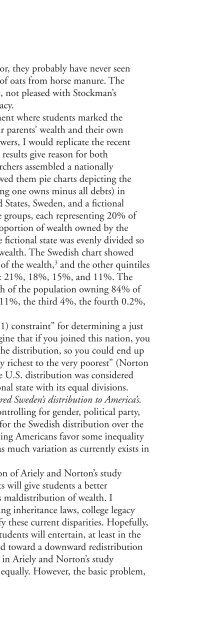WINTER 2012 - National Association of Schools of Public Affairs and ...
WINTER 2012 - National Association of Schools of Public Affairs and ...
WINTER 2012 - National Association of Schools of Public Affairs and ...
Create successful ePaper yourself
Turn your PDF publications into a flip-book with our unique Google optimized e-Paper software.
Creating Quality<br />
Online Course Design Through<br />
a Peer-Reviewed Assessment<br />
Pamela A. Gibson <strong>and</strong> Pamela Trump Dunning<br />
Troy University<br />
ABSTRACT<br />
In online instruction, the effectiveness <strong>of</strong> the learning experience is manifest,<br />
in part, in the course design (Yang & Cornelious, 2005). The investment<br />
in up-front planning <strong>of</strong> a course is critical to constructing a comprehensive<br />
plan <strong>of</strong> instruction. It expresses the intentions <strong>of</strong> instruction, the methods <strong>of</strong><br />
delivery <strong>and</strong>, most important, the assessment <strong>of</strong> learning necessary to produce<br />
learned graduates <strong>of</strong> our institutions. This paper explores the incorporation<br />
<strong>of</strong> Troy University’s Quality Assurance Initiative (QAI), based on Quality<br />
Matters (QM) principles, to conduct a peer-reviewed evaluation <strong>and</strong><br />
subsequent improvement <strong>of</strong> online course design within its Master <strong>of</strong> <strong>Public</strong><br />
Administration (MPA) program. The authors <strong>of</strong>fer several key components to<br />
quality course design, specific components <strong>of</strong> the design that aid the student<br />
in underst<strong>and</strong>ing <strong>and</strong> following course instruction, <strong>and</strong>, finally, suggestions<br />
for continuing to improve online course design to meet the challenges that<br />
come with new technology <strong>and</strong> a new generation <strong>of</strong> students with advanced<br />
technological skill sets <strong>and</strong> expectations from their educational experience.<br />
Online education has grown exponentially during the last decade. According<br />
to a recent Sloan Consortium report, higher education online enrollments are<br />
exp<strong>and</strong>ing at a faster rate than overall enrollments. The compounded annual<br />
growth rate in online students (2002–2008) is 19% as compared to an annual<br />
growth rate <strong>of</strong> 1.5% for the higher education student body on the whole.<br />
Currently, over one quarter (4.6 million) <strong>of</strong> all higher education students<br />
are now taking at least one online course (Allen & Seaman, 2010). Many<br />
degree programs <strong>of</strong>fer classes in multiple formats, from completely online to<br />
a combination <strong>of</strong> online <strong>and</strong> in-class, usually referred to as blended or hybrid<br />
(Allen & Seaman, 2010; Coogan, 2009). The blended, or hybrid, courses<br />
consist <strong>of</strong> some combination <strong>of</strong> both online <strong>and</strong> face-to-face instruction using<br />
JPAE 18(1), 209–228<br />
Journal <strong>of</strong> <strong>Public</strong> <strong>Affairs</strong> Education 209

















